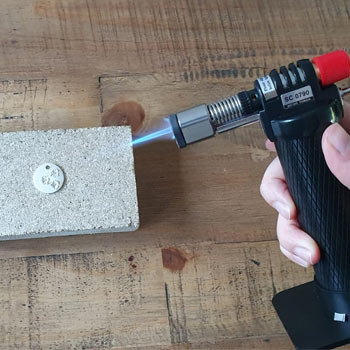Silver Clay was invented in Japan in the 1990s by metallurgist Masaki Morikawa. For many, it has been a revelation which has allowed fine jewellery to be made simply without the need for years of training or multiple sets of expensive tools. However, there are those who still believe it to be nothing short of witchcraft. After all, how can clay be real silver?
Here we will answer some of the most commonly asked questions about silver clay and try to dispel some of the myths which surround this fabulous material.
Is silver clay really silver?
In short, yes! Silver clay is either 925 Sterling Silver or 999 Fine Silver and can be hallmarked as such.
How does it work?
Silver clay is made up of thousands of tiny silver particles held together in an organic binder. As the clay dries, the moisture from the binder evaporates. When heated, it burns away completely leaving only sintered metal. The heat causes the metal particles to fuse together to form a solid mass, which is how the metal (in the traditional sense) is formed.
How can it be used?
Silver clay is very soft and pliable. It can be moulded by hand just as you would with any regular ceramic clay. It can also be rolled, textured and sculpted using only a few simple tools, to produce jewellery and small objects.
Do you need a kiln?
Not necessarily. Some types of metal clay require a kiln to reach the required temperature for sintering. However, others can be successfully fused using only a handheld torch.
Can it be hallmarked?
Yes. Silver clay can be hallmarked just as you would any other piece of silver. Standard silver clay can be hallmarked .999 Fine Silver and Sterling can be marked as .925
How quickly does the clay dry?
As soon as silver clay is exposed to the air, it will begin to dry. So it is essential to keep any spare clay wrapped in cling film and in an air tight container to keep it malleable. Once the clay starts to become ‘leather-hard’ it will hold its shape. To ensure it is fully dry ready for firing, it needs to be left overnight or heated with a hairdryer or placed in a warming drawer. The thinner the clay, the quicker it will dry. If you are creating delicate shapes, you will need to work quickly and choose softer clay which will give you an extended working time.
Can silver clay be rehydrated once it has dried out?
Yes. Add a few drops of water to leather – hard clay and knead with your hands to make it fully pliable again. It’s also possible to revive small pieces of completely hard clay (pre-fired clay only) by grinding it down and adding enough water to form a paste known as slip. Keep this slip in an air tight container and it can be used to bond pieces of clay together like glue.
Why are there different types of silver clay?
The different types of silver clay available will deliver a range of varied properties. So it is essential to choose the right one for your chosen project. Some are stronger which can mean a firmer clay. These dry quicker and suitable for pieces requiring good durability. Some meanwhile are smoother than others. This can result in a sticky texture that has a longer working time, which is ideal for more complicated designs. You will also find a range of different metals to choose from including 925 Sterling Silver and 999 Fine Silver as well as Gold, Copper and Bronze versions so there are many decisions to make.
Why do I need to know about shrinkage?
Silver clay shrinks during the heating process as the binding agent is burnt away and the silver particles fuse. Shrinkage rates vary across the product ranges from approximately 10% – 30% so consider this during the design process.

Cooksongold

